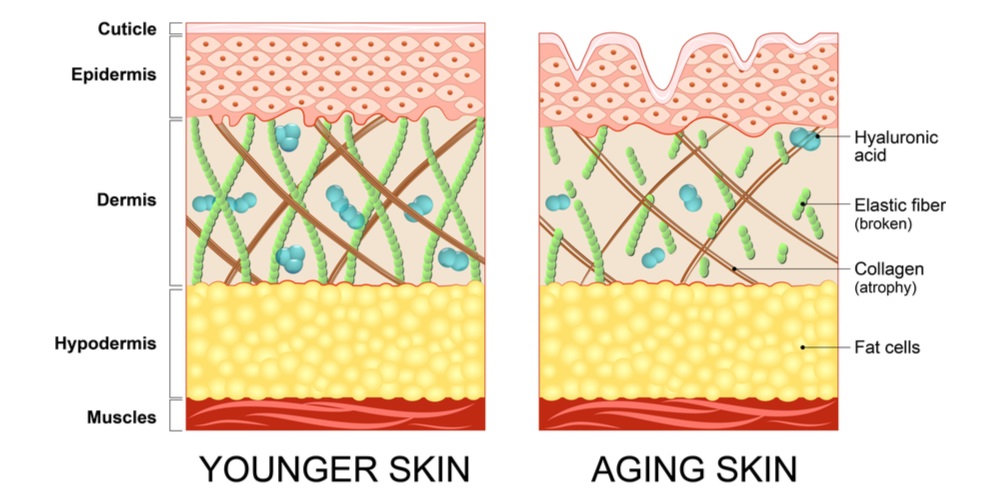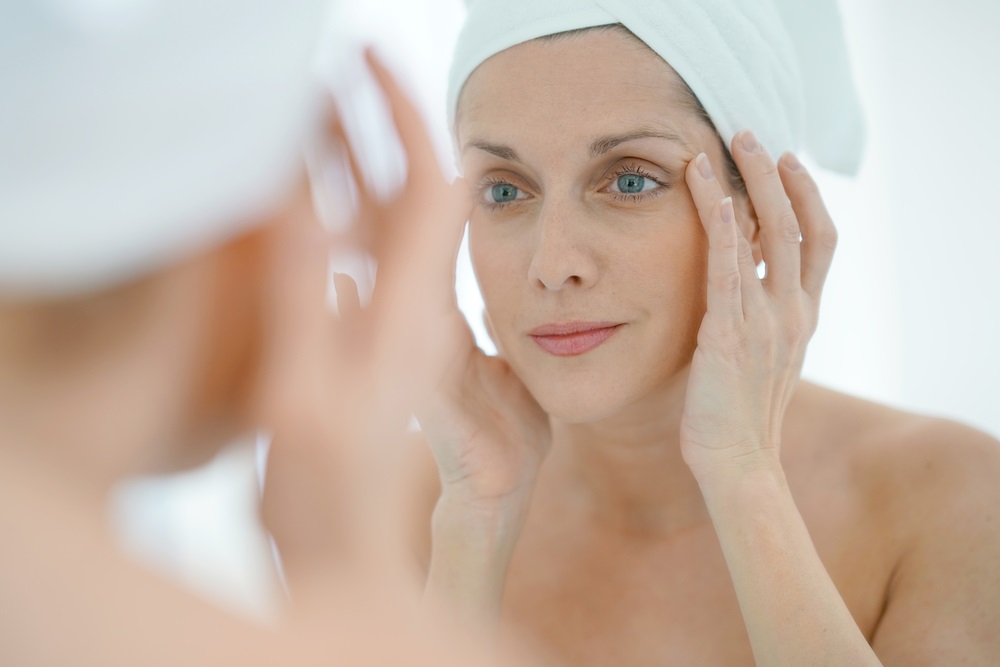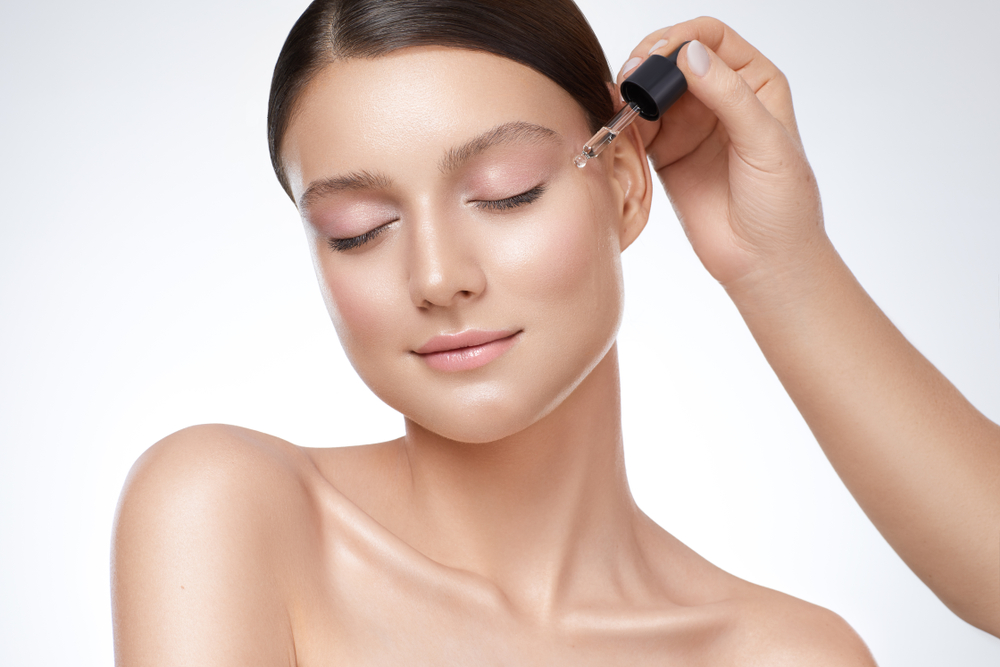- Collagen and elastin are two naturally occurring proteins that work together to keep the skin smooth and flexible.
- The breakdown of these proteins is a common feature of aging tissues, causing structural changes in the epidermis and dermis.
- While certain cosmetic procedures are rendered ineffective by excessive skin laxity, various treatments may still be performed to give the skin a more supple appearance.
Pinch the skin on the back of your hand for a few seconds. Does that skin remain tented until it slowly melts back flat? Or does it snap back right away? This little test gives you a sense of your skin’s elasticity. The faster the snap back — in the medical field they call it “turgor” — the more likely you are to have good skin elasticity.
Here’s what you need to know about skin elasticity loss, along with some advice on how to prevent and treat it.
What’s the difference between collagen and elastin?
Both proteins are produced by fibroblasts, the structural framework of animal tissue. However, they play two very distinct and critical roles.
Collagen gives skin its structure, whereas elastin is the stretchy protein responsible for its elasticity.
“Collagen and elastin are both important for youthful vigor, but have different physical structures,” says New York City plastic surgeon Dr. Michelle Yagoda. “Collagen has a triple-helix structure that provides strength and stores energy well. Great force is required to distort it. By contrast, elastin’s structure is disordered. This makes it super flexible and easy to stretch.”
Think of collagen as the protein that gives your skin its volume and plumpness. Elastin gives it resilience and stretch.
“For instance, older people may have a lot of hanging, loose skin on their arms, knees, or under the chin — even if they are in good shape. Those problems are related to loss of elasticity,” Dr. Yagoda explains.

What causes the skin to lose its elasticity?
Elastin loss is part of the natural aging process, and partially pre-programmed by our genes.
“If you look at five different people in their sixties, each one will have a different level of skin elasticity — even if they all have the same lifestyle habits,” says to Dr. Yagoda. “Part of the loss is caused by genetics, and part is environmental.”
The most common environmental factor is sun exposure. So as it is with preventing almost every aspect of skin aging, you must wear sunscreen.
Studies have also demonstrated a strong link between stress and skin aging: stress and its production of the hormone cortisol cause inflammation in the skin and elastin breakdown.
Are cosmetic procedures less effective when the skin lacks elasticity?
Waning elasticity has a direct impact on surgical results, says Dr. Yagoda. For instance, a satisfactory outcome may be more difficult to achieve in face and neck lift patients whose skin doesn’t “bounce back.”
“Even if you pull the jawline into a good position, the skin will start to drape again, or it won’t look natural — it will look over-pulled,” says Dr. Yagoda.
And while some non-invasive treatments remain effective on inelastic skin, others are bound to disappoint.
Volumizing hyaluronic acid fillers like Voluma won’t be able to lift the skin and create the desired restorative effect. These fillers are often injected deep below the muscles along the cheekbones, to lift the skin from the inside out. If skin is drooping and inelastic, it will sag despite the added structural support of the filler.
“If you have good elasticity, you can use fillers to achieve a natural result,” Dr. Yagoda confirms. “But if you’ve lost a lot of elasticity and your goal is to plump up the area, you might end up looking over-inflated.”
Neurotoxins like Botox and Xeomin aren’t impacted by elasticity loss, since they work by paralyzing muscles to curb motion wrinkles. Lasers treatments, peels, microneedling, and other collagen-inducing therapies are also viable options — even on inelastic skin they can effectively build collagen, correct redness, and fade dark spots.
Can specific foods or supplements help improve skin elasticity?
Unfortunately, changing your diet and taking supplements won’t restore elasticity. As you age, the rate at which your skin produces elastin will slow — omega-3 fatty acids, vitamins, and other supplements won’t halt this decline.
However, proper diet can ensure that you don’t lose elastin at an unnecessarily fast pace. You can hold on to what you have.
“Not only is a diet with a sufficient amount of protein necessary, but the body also requires the minerals zinc, manganese and copper to produce collagen and elastin,” says Dr. Yagoda. These minerals fuel the chemical process that creates the two proteins so your body can naturally replenish.
Whether or not you should take supplements will depend not only on your diet, but also on your body’s ability to absorb the nutrients you consume.
“If your diet is low in protein, you may not be giving your body enough to repair and create the things it needs,” says Dr. Yagoda. “And even if you do follow a healthy diet, 1 in 3 people have problems with proper absorption.”
To know whether or not you’re getting the right amount of protein and minerals, research the guidelines based on your age, activity level and sex. This can be done online with tools such as the United States Department of Agriculture’s Dietary Reference Intakes calculator.
“For example, a marathon runner will need more protein than a person who sits at a desk all day,” says Dr. Yagoda.
You can also discuss your targets with a nutritionist. And if you suffer from a condition like inflammatory bowel disorder or celiac disease, ask your doctor if those disorders will impact nutrient absorption (they likely will).
Also look for outward signs of dietary deficiencies: are you losing hair, bruising easily, or having trouble with your skin? “These are clues that your gut may be something to look at,” says Dr. Yagoda.
How can I improve my skin’s elasticity?
There are many ways to boost collagen production, but the experts we spoke with aren’t aware of any clinically proven treatments that help improve the skin’s elasticity.
Accordingly to Dr. Yagoda, prevention is the best medicine.
“It’s easier to adhere to a strict preventive regimen than to attempt to regain elasticity later in life,” she says.
Cosmetic laser specialist Jeannel Astarita is of the same opinion. At her busy aesthetics studio in New York City, patients undergo Sculptra injections, shockwave therapy, and various other skin rejuvenation treatments to stimulate collagen renewal. Jumpstarting elastin production, however, remains an elusive challenge.
“While collagen loss makes the skin thinner, elastin loss decreases its turgor,” Astarita explains. “As far as I know, there haven’t been any studies of cosmetic treatments that actually measured the regeneration of elastin by viewing the tissue under a microscope.”
Anecdotally, though, she has found that some procedures and products may help.
First, Astarita suggests the use of retinoids to improve skin turgor. “I’ve never seen anything better than retinoids at increasing elasticity,” she says.
Ultherapy, a skin tightening treatment that directs ultrasound energy deep within the dermis, can also help address moderate skin laxity. Astarita confirms that her patients’ skin definitely looks tighter and better draped after undergoing Ultherapy treatments. However, recent histological studies do not indicate that ultrasound brings any changes to the skin’s elastin composition.
As for specific cosmeceutical products, Astarita recommends Defenage. The skincare line contains a patent-pending peptide that, according to the brand’s website, communicates with the skin’s stem cells to help correct the signs of aging.
Although she acknowledges that there is a lack of substantiating scientific data, in Astarita’s opinion “Defenage, Ultherapy and Retin A are you best shots at restoring elastin.”









